Rye:-a powerhouse of fiber grains
{content:- Definition, common name, Characteristic of Rye grain, structure, Difference b/w Rye, oats & Barley, culinary use, brief history, cultivations, Rye flaks, Rye sprouts, popular dishes, Nutritional value & Health benefit, common brand names etc}
What is Rye grains?
Rye is a cereal grains belong to the wheat family called “Poaceae” which is closely related to the (Hordeum) and wheat (Triticum)crop. It is known for its hard grain as compare to the wheat grain.
- The botanical name of Rye grains is “Secale Cereal” It is mainly cultivated for edible grains that are mainly used for the preparation of Rye flour for making breads & for brewing liquors such as Rye whiskey & animal feed.
- Rye grains also contain gluten and it is one and only cereal grains other than Wheat that has almost same quality of making loaf or dough for bread making. Although Rye grain is inferior to wheat grains in terms of gluten content resulting it lacks in elastic dough and its darker color rye flour produces brown color breads.
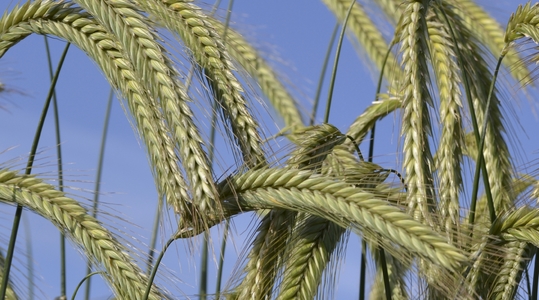
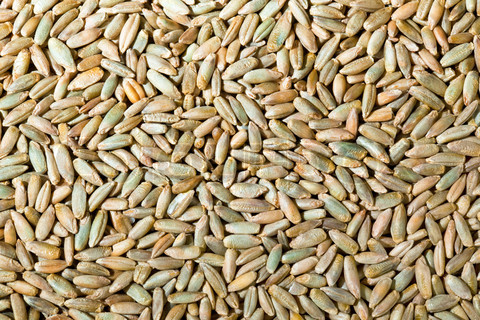
Pic source-yara.ie & Albert lea seed
Characteristic of Rye grain:-
Appearance of Rye grain:-
- The shape of Rye grain is elongated.
- Color of Rye grain is grayish green to yellowish brown.
- Flavor of rye grain is slightly sour and earthy flavor.
- Texture of Rye flour produces denser & darker bread as compare to the wheat bread.
- Rye grains contains less gluten than wheat grain.
- Due to difficult to separate the Rye bran & Rye germ from its endosperm, it is usually milled whole to get rye flour which is highly nutritious. Whereas in case of wheat, the bran & germs can easily separate from endosperm to get refined flour.Rye is the only cereal grains other than wheat grain which have the necessary properties for bread making.
- Rye gluten is of poor quality resulting its gluten does not have very much strength & power to make elastic and stretchable dough to trap air bubbles during fermentation of the bread.
- Due to this poor characteristic, bread made from Rye flour does not expand as much as bread made with wheat flour resulting Rye is usually mixed with 25 to 50% wheat flour for bread making.
Common name of Rye:-
- Botanical name:– Secale cereale L.
- In English:- Rye, spring Rye or Winter Rye.
- In French: seigle(Rye), seigle de printemps (Spring rye), seigle d’hiver(winter rye)
- In Spanish: centeno(Rye), centeno de verano(Spring rye), centeno de invierno(Winter rye)
- In Italy: segale(Rye),segale primaverile(spring rye), segale invernale(Winter rye)
- In Netherlands: Rogge(Rye), Winterrogge(winter rye); Zomerrogge(Summer rye)
- In Sweden: hoestraag, raag, vaarraag
- In Portuguese: centeiro or senteiro
- In Danish:- Rug
- In Dutch:-Rogge
- In German:-Roggen
- In Hindi:– Neivarika (नीवारिका), “राई” (rai)
Rye is not as commonly used in Indian cuisine as other grains like wheat, rice, or barley, but it is recognized in regions where it is grown or used.
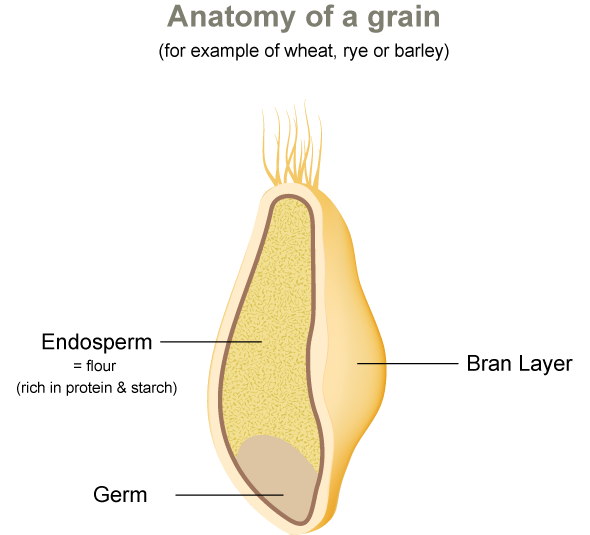
Pic source:- ResearchGate
- A good quality of Rye grains contains 10-15% of bran, 80-85% endosperm & 2-3% of germ.
- The outer layer of the endosperm of Rye grains called “aleurone” which is tightly closed with Rye bran surface resulting very difficult to separate from the Rye grain during milling.
A brief history of cultivation of Rye crop:-
It is believed to have originated of Rye grain as a weed in wheat & barley fields. it is thought to have first been domesticated in what is now modern-day Turkey, Syria, and Iran around 4000 BCE.
- Rye began spreading into Europe around 2000 BCE. Its ability to thrive in poor soils and cold climates made it a valuable crop for Northern and Eastern Europe, where conditions were less favorable for wheat and barley. Although Rye grains have been found in Roman context along the Rhine River & Danube River in European countries.
- During the medieval period, rye became a staple food source in Europe. It was particularly important in Germany, Poland, and Russia, where rye bread (often darker and denser than wheat bread) became a dietary mainstay.
- In the 18th and 19th centuries, agricultural advancements and the development of hardier rye varieties improved yields and resilience.
- Rye was introduced to North America by European settlers in the 16th and 17th centuries. It was cultivated in the colonies, particularly in the northeastern United States and Canada, where it adapted well to the climate.
- In addition to its use as food, rye has been used in the production of alcoholic beverages like rye whiskey and certain types of beer.
Rye Producing countries:-
- Germany: Germany is one of the largest producers of rye in Europe and is known for its extensive use of rye in bread-making and other food products.
- Poland: Poland is another major producer of rye, with rye bread being a staple in Polish cuisine.
- Belarus: Belarus also has a substantial rye production, contributing significantly to its agricultural economy.
As per the USDA 2023 Data, top producing countries of Rye are :-
- European Union:- 66% of total global production ( 7.63 million tones)
- Russia:-15% of total global production (1.7 million tones)
- Belarus:– 7% of total global production ( 0.7 million tones)
- Canada & Turkey:- 3% of total global production sepeartely.(0.3million tones)
Rye production in India:-
- Rye is not a staple crop in India. The cultivation of Rye grains in India is almost Nil as we mainly cultivate wheat as a staple crop.
Culinary use of Rye grains:-
- As a Flour:- Whole rye grains are milled to make rye flour which contains bran, endosperms & germs. Rye flour has brown in color & nutty flavor which can easily distinguish from wheat flour.
As a Bread and Baked Goods:
- Rye Bread: One of the most common uses of rye, especially in countries like Germany, Poland, and Russia. Varieties include pumpernickel and sourdough rye bread.
- Crispbread: Thin, crispy bread made from rye, popular in Scandinavian countries.
- Rye flour are determined by how much the rye kernel i.e Bran, endosperm & germ are present.
As a Alcoholic Beverages:
- Rye Whiskey: A type of whiskey made from a mash that consists of at least 51% rye.
- Beer: Rye is sometimes used in brewing certain types of beer to add a unique flavor.
As a Breakfast Cereals, Snacks & Pasta:
- Rye Flakes: Similar to rolled oats, used in muesli and granola.
- Rye Crackers: Popular as a healthy snack option.
- Rye Pasta: Used in some specialty pasta products.
- Rye Flour: Used in various baking applications, including cakes, pastries, and cookies.
Product made from Rye Grain:-
Rye flour is a key product made from rye grain. It is used in various culinary applications and has distinct characteristics compared to wheat flour.
Rye flour are available in two forms in market:-
(1) Whole Rye flour:- Whole rye flour is obtains from the milling of the whole rye grains without removal of bran & germ. Its flour is darker in color, more intense rye flavour & denser or coarser texture. This is the best quality of rye flour. Whole rye flour is used to make one of the most popular Pumpernickel bread & Rye sourdough bread.


Pic source-Janie mills &veganbaking.net
(2) White Rye flour:-It is the lightest version of rye flour or simply referred as “Light Rye”. In this flour, Bran & germs from the whole rye grains are removed, only starchy endosperms are milled to get white rye flour. Its flour is lighter in color, less rye flavor and smooth in texture.
- Its flour is mainly used to make light breads, cookies & cakes, cupcakes, muffins, pancakes, crepes, Rye waffles etc.
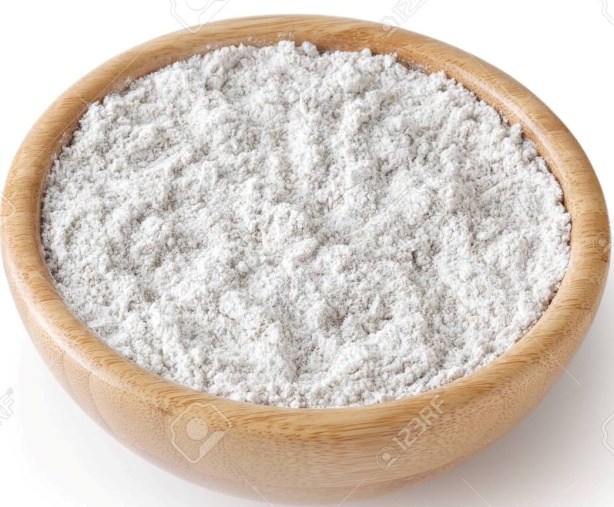
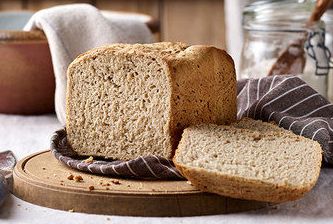
Pic source-123RF.com & Doves farm
(3) Rye Meal:- Rye meal is coarser than Rye flour as it includes few amount of rye bran & germs along with endosperm at the time of grinding.
- It is often used in baking such as Rye crackers or certain types of traditional rye breads.
(4) Rolled rye flakes and rye grits:- Whole rye flakes are usually prepared by boiling the whole rye grains and pressing it to make flakes same as oat flakes. This crispy rye flakes which have a blue-green color are generally eaten as a porridge or breakfast cereals. Rye flakes can also be used as a binding or stuffing ingredients in making hamburgers, patties etc.
Whereas Rye grits are fine rye kernels which is cracked and used as a breakfast cereal .
Picture of Rye flakes & Rye grits

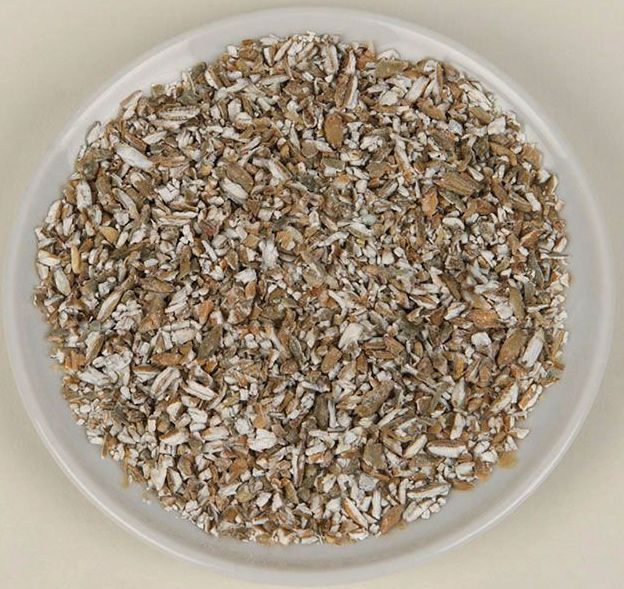
Pic source- eatwholefood & Multiflour
(5)Used to make Rye sprouts:- Rye sprouts is one of the healthiest option to have in the breakfast & in salads. Sprouts can be prepared by soaking the whole rye grains for at least 6-8 hrs and then allow to germinate. The germinated rye sprouts will have a bit sweet, chewy and highly nutritious and provides a great amount of energy, protein, fiber, minerals and vitamins etc.
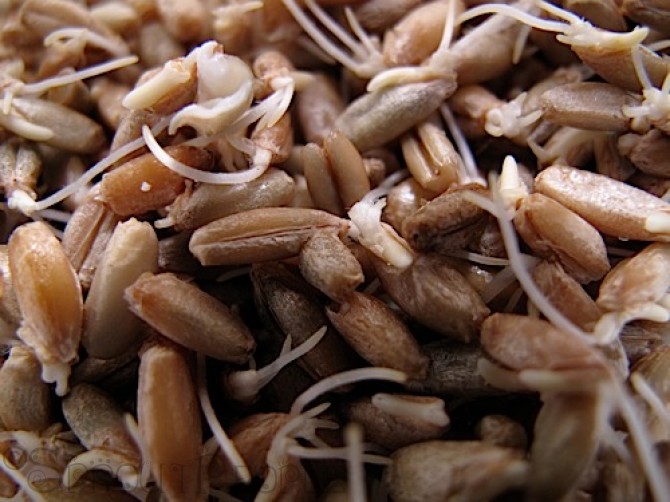
Pic source-sproutpeople
(6) Used to prepare beverage:- Rye grains are extensively used to make fermented beverage like Rye beer as well as distilled beverage Rye whiskey. Rye whiskey is slightly spicier than traditional whiskey made from barley or corn.
Rye Whiskey:
- American Rye Whiskey: Made from a mash bill that includes at least 51% rye, giving it a distinctive spicy and fruity flavor.
- Canadian Rye Whiskey: Known for its smoothness and complexity, often including a higher proportion of rye.
- Rye Beer:
- Rye Beer: Brewed with rye malt, contributing a spicy and earthy flavor to the beer.
- Most popular brand of rye whiskey are:- Jack daniels, Rittenhouse, Jim Beam, Redemption & Bulliet etc.

- Most popular rye beer is:- The Bavarian roggenbier is a special kind of beer containing upwards of 60% rye malt. Other rye beer brands are- Red rye, Ruthless etc

Popular Dishes made from Rye grain:-
Rye grain is used to make a variety of dishes and baked food items due to its unique flavor and texture. Here are some popular dishes and products made from rye grain:
(1) Rye Bread:
- Pumpernickel: A dense, dark bread made from coarsely ground rye flour. It often includes molasses or other sweeteners and is traditionally baked for a long time at low temperatures.
- Rye Sourdough: A type of sourdough bread made with rye flour, known for its tangy flavor and dense texture.
- Rye Sandwich Bread: A lighter, soft bread made from a mix of rye and wheat flours.
(2)Rye Crackers:
- Crispbread: Thin, crisp bread made from rye flour, popular in Scandinavian countries. It can be enjoyed with various toppings or as a snack.
(3) Rye Pastries and Cookies:
- Rye Cookies: Cookies made with rye flour, which can offer a unique flavor compared to those made with wheat flour.
- Rye Muffins and Cakes: Baked goods such as muffins or cakes that incorporate rye flour for a distinct taste.
(4)Breakfast Foods:
- Rye Porridge:
- Rye Flakes Porridge: Made from rye flakes or cracked rye, cooked with milk or water and often served with fruits, nuts, or honey.
- Rye Muesli:
- Rye-Based Muesli: A mixture of rye flakes with other grains, nuts, and dried fruits, typically eaten with yogurt or milk.
(5) Rye-Based Soups:
- Rye Flour Thickening: Rye flour can be used to thicken soups and stews, adding a unique flavor and texture.
Traditional and Regional Dishes:
- Borscht: it is a beet soup containing rye flour as a thickening agent or as a component in dumplings.
- Kashka: A traditional dish from Eastern Europe, made from rye and often served as a side dish or a main course.
- Borodinsky Bread: A traditional Russian rye bread flavored with coriander and molasses, known for its rich taste and dark color.
- Rye Crispbread (Knäckebröd): A staple in Scandinavian cuisine, often eaten with butter, cheese, or other toppings.
- Rye Crackers: Thin, crunchy crackers made from rye flour, popular as a snack or appetizer.
- Russian Rassolnik: A traditional Russian soup that may include barley, but sometimes rye is used to thicken the broth.
- Rye Pancakes (Ruispannukakku):A Finnish dish made from rye flour, eggs, milk, and often baked into a thick, custard-like pancake.
- Rye Flour Dumplings: Used in various Eastern European dishes, these dumplings can be served in soups or as a side dish.
- Rye Cookies: Made with rye flour, offering a unique flavor compared to traditional wheat-based cookies.
- Rye Cake: A cake made with rye flour, which can have a denser texture and slightly nutty flavor.
Nutritional value & Health benefit of Rye grains:-
Rye grain offers several nutritional benefits and is a good source of various essential nutrients. Here’s a breakdown of its nutritional value per 100 grams of raw rye grain:
Nutritional Profile:
- Calories: Approximately 338 kcal
- Protein: About 10 grams
- Carbohydrates: Around 75 grams
- Dietary Fiber:– Approx- 15gms
- Vitamin B1, B2,B3, B5, B5 &B9
- Minerals:- The main minerals present in Rye grains are:- Phosphorus ( 340mg), Magnesium- 110mg, Iron- 3.6mg & Zince- 2.5mg
Health benefit:-
- Rye is an excellent source of water insoluble dietary fibre & partly water soluble dietary fibre- “Arabinoxylan” which helps to protect cardiovascular problems as well as gastrointestinal issues.
- Rye grain also contains good amount of Protein, starch, free sugar & other bio-active compounds which have numerous positive benefits for digestion & our health.
- The bread which is made with Rye flour will have 03 times more dietary fibre than bread made with refined wheat flour.
- Rye grain is a great source of antioxidants, minerals, lignans as well as other phyto-nutrients.

Nutritional comparison of Rye grains with other cereal grains
(The comparison has been done after referring various nutritional website like healtline.com, nutritionalvalue.org, nutritionnix.ciom, grain & legume nutrition council, webmd.com etc)
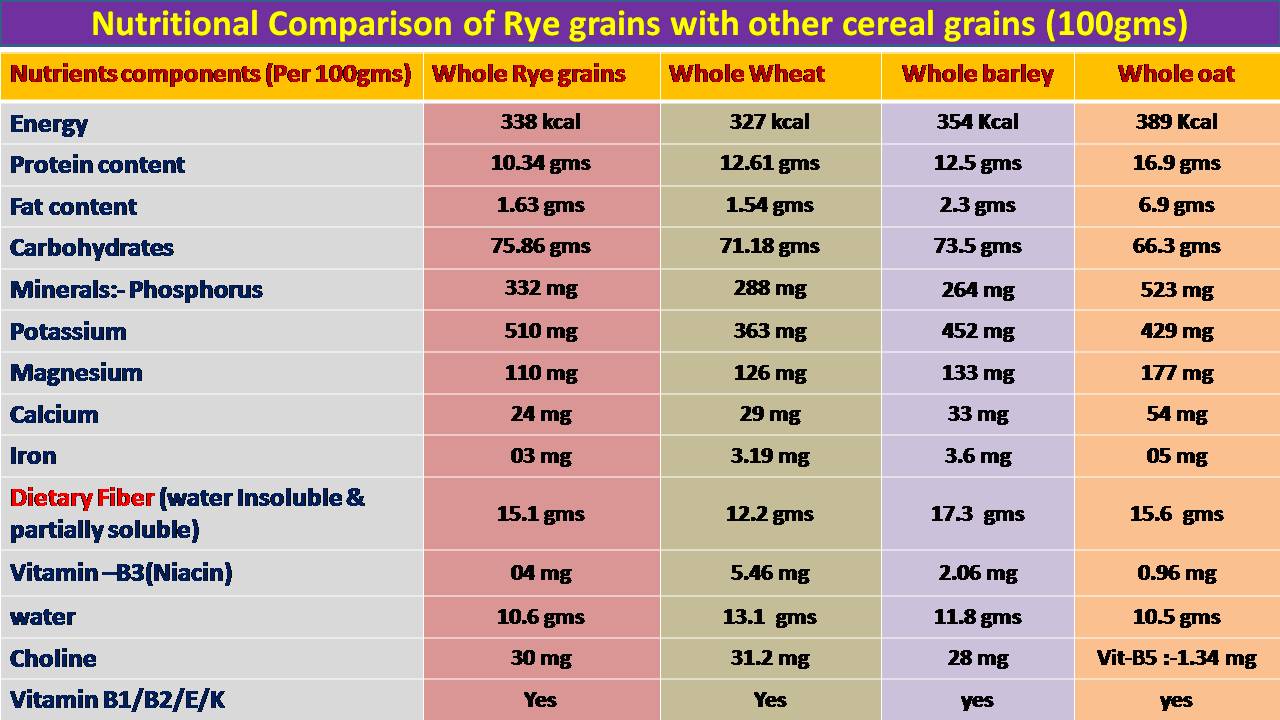
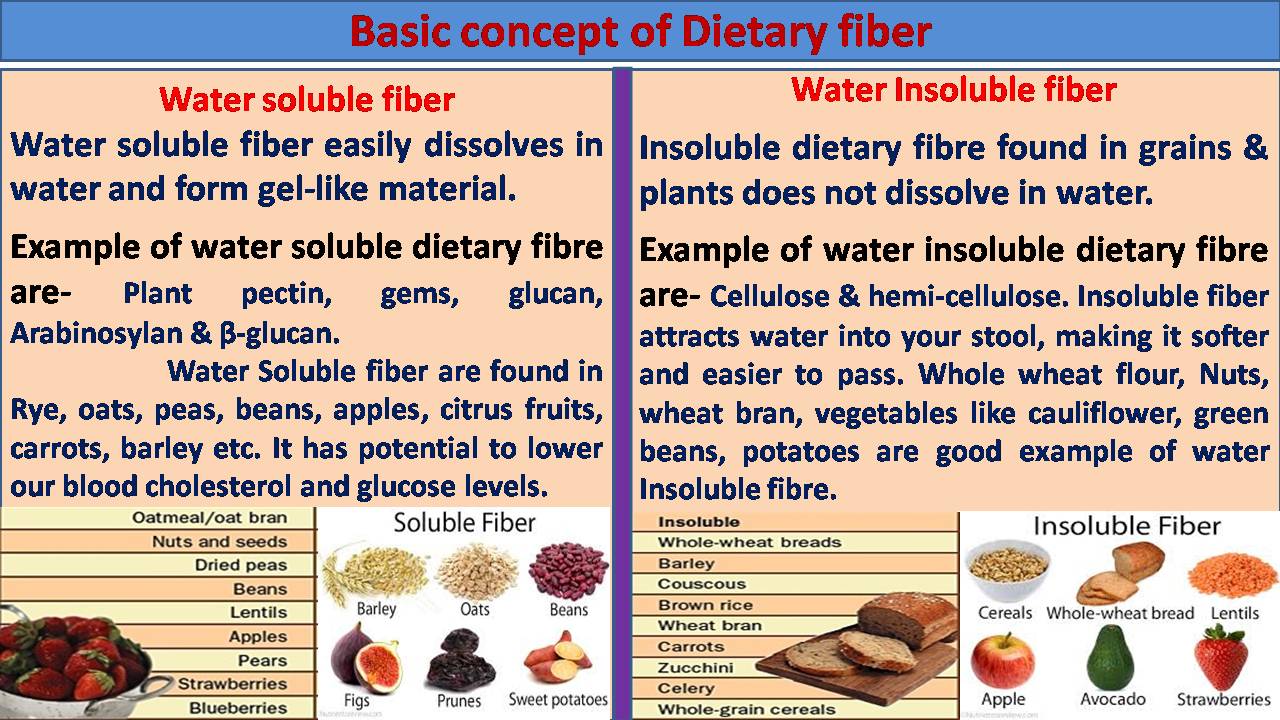
Content Ref:-
- wikipedia.com
- wissbake.in/blog/rye-a-powerhouse-grain-with-excellent-flavour-profile
- https://www.sciencedirect.com/topics/pharmacology-toxicology-and-pharmaceutical-science/rye
- https://positivelyprobiotic.com/the-bacteria-blog/rye-an-origin-story
- https://www.foodrepublic.com/1293808/things-you-didnt-know-about-rye/
- https://www.brooksgrain.com/Blog/ArticleID/64/4-Fun-Facts-About-Rye
- https://www.thespruceeats.com/what-is-rye-1328644
- https://www.threeonefarms.com/post/rye-a-grain-from-the-past-for-the-future
- https://wholegrainscouncil.org/whole-grains-101/grain-month-calendar/rye-triticale-august-grains-month/types-rye
- https://www.feedipedia.org/node/12542
- https://greatbasinseeds.com/product/rye-grain/
- Research paper from Department of plant science, University of wyoming
- https://www.indexmundi.com
- feedipedia.org
- www.glnc.org.au
- healthline.com
- britanica.com
- www.hort.purdue.edu
- wholegraincouncil.org
- academia.edu
- sciencedirect
- researchgate
- canadanian encylopedia
- https://www.botanical-online.com
- grain research & development corporation.
